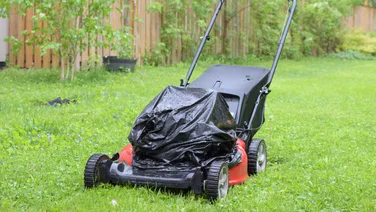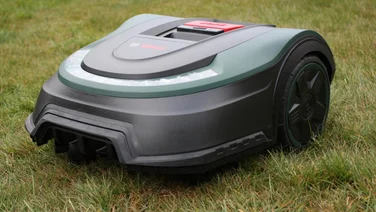To help us provide you with free impartial advice, we may earn a commission if you buy through links on our site. Learn more

There’s no denying that robot lawn mowers are one of life’s luxury purchases, arguably even more so than robot vacuum cleaners. However, considering they’ll keep your lawn in superb condition all year round without you having to so much as lift a finger, you might come to the conclusion that they’re worth not just the cost, but their weight in gold.
That said, as with all expensive purchases, you should know what you’re paying for and whether the technology actually works. To give you the rundown on robot lawn mowers – the different types, how they work and how they navigate a garden – we spoke to Ryan Patterson, residential segment manager at Husqvarna UK, a company that’s been in the robot lawn mower business for decades.
What is a robot lawn mower?
You might be someone who enjoys wrestling your old, traditional lawn mower out of the shed every week or so, driving it up and down the garden and then painstakingly finishing the edges off with some scissors. Or you might be someone who finds mowing the lawn as tedious a chore as painting your fence and then watching it dry. If you’re the latter, that’s where robot lawn mowers come in. These autonomous, or semi-autonomous, robots not only cut your grass for you but do so without you even having to think about it – little and often is their secret to keeping a lawn in good shape.

“Robotic lawn mowers are a great option for garden owners as they use innovative technology to replace traditional lawn-cutting methods”, Ryan Patterson of Husqvarna explains.
He also notes that “the sound level of a robotic lawn mower is very low”, so you won’t disturb your neighbours as much, and that they’re “weatherproof, meaning they can cut the lawn 24/7, day or night and rain or shine”, something we certainly can’t say for ourselves – even if you adore gardening, would you be out cutting your lawn at 6am every day?
READ NEXT: Best cordless lawn mowers
How do robot lawn mowers work?
How robot lawn mowers work depends on the type of model you have, but most are battery-operated with a charging station that is mains powered. They usually run on a schedule you set – whether programmed directly into the device or set up using an app – and will automatically return to their charging base once they have completed their mow, or if they need to recharge mid-mow.
“Most robotic lawn mowers are completely smart home-integrated, and you can customise your mowing schedules in apps, such as the Automower Connect app, and define your working area with a physical or virtual boundary at the push of a button on your smartphone,” Patterson says. “This allows you to save all-important time while your robotic mower does the hard work.”
The way a robot lawn mower cuts the grass is different to a traditional lawn mower and arguably better for your lawn. They aren’t designed to lop 6 inches off your lawn, just like how a robot vacuum cleaner isn’t designed to carry out a deep spring clean. Instead, robot lawn mowers are intended to trim your grass frequently, so it never gets long in the first place and always looks neat, tidy and freshly cut.
“Robotic lawn mowers use varied cutting patterns and modes to safely and precisely cut the lawn little and often, while minimising any risk of wheel tracks and wear on the lawn. The grass clippings are then small enough to be recycled back into the lawn as a natural fertiliser”, Patterson explains.
What types of robot lawn mowers are there?
Robot lawn mowers have been around for quite some time: Husqvarna launched the first solar-powered robot lawn mower way back in 1995, long before smartphones were a thing and before we even had cameras on phones, let alone apps to control lawn mowers. It worked quite differently from how robot lawn mowers work these days, but the basic principle remains.
There are various manufacturers of robot lawn mowers, from more established brands, like Husqvarna, Bosch and Worx, who have larger portfolios with multiple models suited to different needs, to companies new to gardening, such as Segway, who can only offer one or two models. Today’s robot lawn mowers are typically all battery-operated, and they have similarities, but they aren’t all the same.
“There is a robotic lawn mower for every garden”, Ryan Patterson says. He goes on to explain that “there are so many robotic mower models available now at different price points and for different-sized gardens, all with their own unique features”.

He adds that you can find “options for both boundary-wire and boundary-wire-free mowing, catering to varying shapes and sizes of gardens – even those with more complex designs and slopes.”
You can find robot lawn mowers in a variety of sizes, with different levels of capability when it comes to tackling inclines, but you can also find a range of different smarts and features too, from ‘Rewilding Mode’ on Husqvarna mowers, to ‘SpotMow’ on Bosch mowers. However, while there’s a huge variety of robot mowers, most of them can be split into one of two categories: those that require boundary wire and those that use GPS.
READ NEXT: Best lawn mowers for a small garden
How do robot lawn mowers navigate?
As Ryan Patterson explains, “A lot of traditional robotic lawn mowers for the home garden navigate within a physical boundary wire, meaning it will operate within the zones you set using a guide wire”, requiring you to peg the wire around the perimeter of your garden.Alternatively, many of the more recent models use GPS to find their way around your garden, allowing you to set a virtual boundary with your smartphone. Ryan adds: “With the wire-free mowers that have entered the market, it’s all done by a virtual satellite and a reference station. Robotic lawn mowers come with built-in intelligence, meaning they can navigate and handle most obstacles, reducing the need to regularly check up on it.”
There are pros and cons to both methods. For example, with boundary wire you have to allow for some breakages, and there is a risk that animals will dig the wire up, meaning replacement of some parts of the boundary is all but inevitable at some point. However, the physical boundary does mean you can be sure the robot lawn mower will stay in its lane.
With GPS navigation, some robot mowers will have a satellite receiver that needs to be close to the charging station and with a clear view of the sky, which will restrict where you can place the base. Additionally, as there is no physical guide to stop the robot mower from drifting into flower beds or off of ledges, you need to be quite precise when you map out your garden in their respective app. That said, GPS models are quicker to set up and make restricting areas easier than pegging out boundary wire.
Is a robot lawn mower worth it?
From personal experience, a robot lawn mower is absolutely worth it. While plenty of technology comes and goes, a robot lawn mower is something that has remained. They actually work and they require very little user input – once setup is complete, they are very easy to look after and they make looking after your lawn easy too.

“A robotic lawn mower is the perfect option for someone who doesn’t want to spend time manually mowing the lawn”, advised Ryan Patterson, “freeing up valuable hours for things they enjoy with their low maintenance machine.”
Whether a robot lawn mower is right for you will depend on your garden and your budget, as well as whether you enjoy mowing your lawn or not, but, as Patterson alluded to earlier, they make for a “worthy investment that will have you covered every gardening season.”






